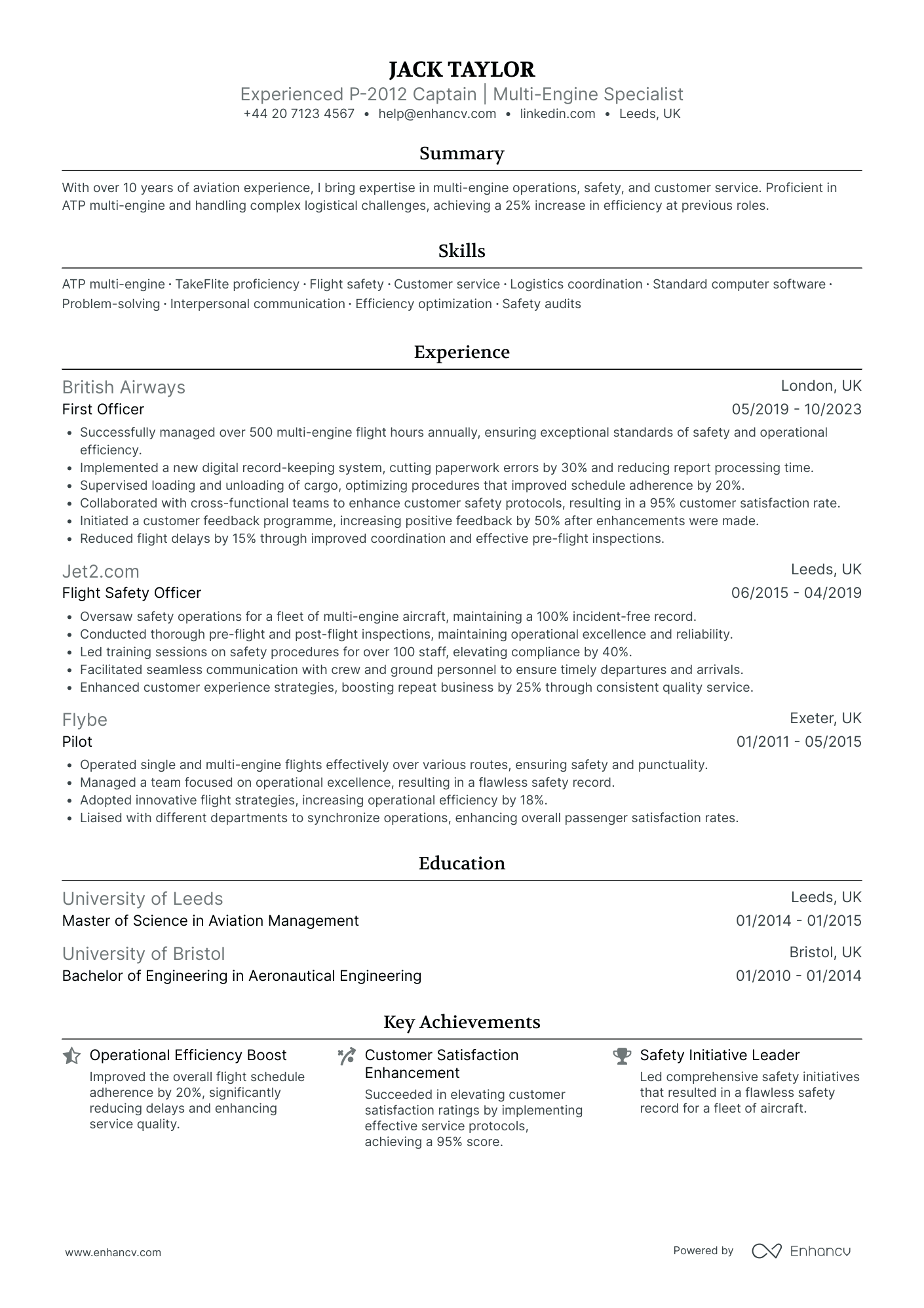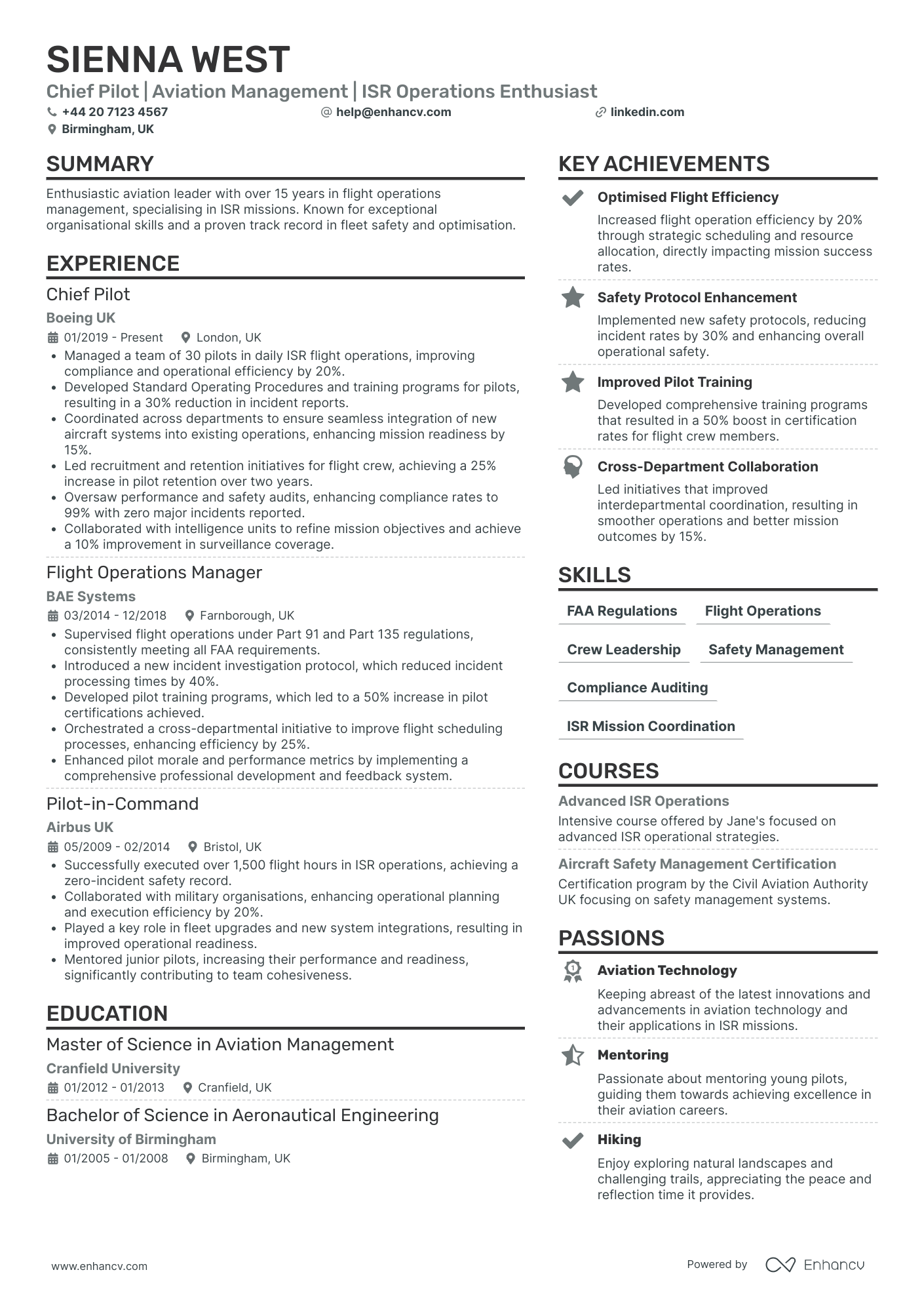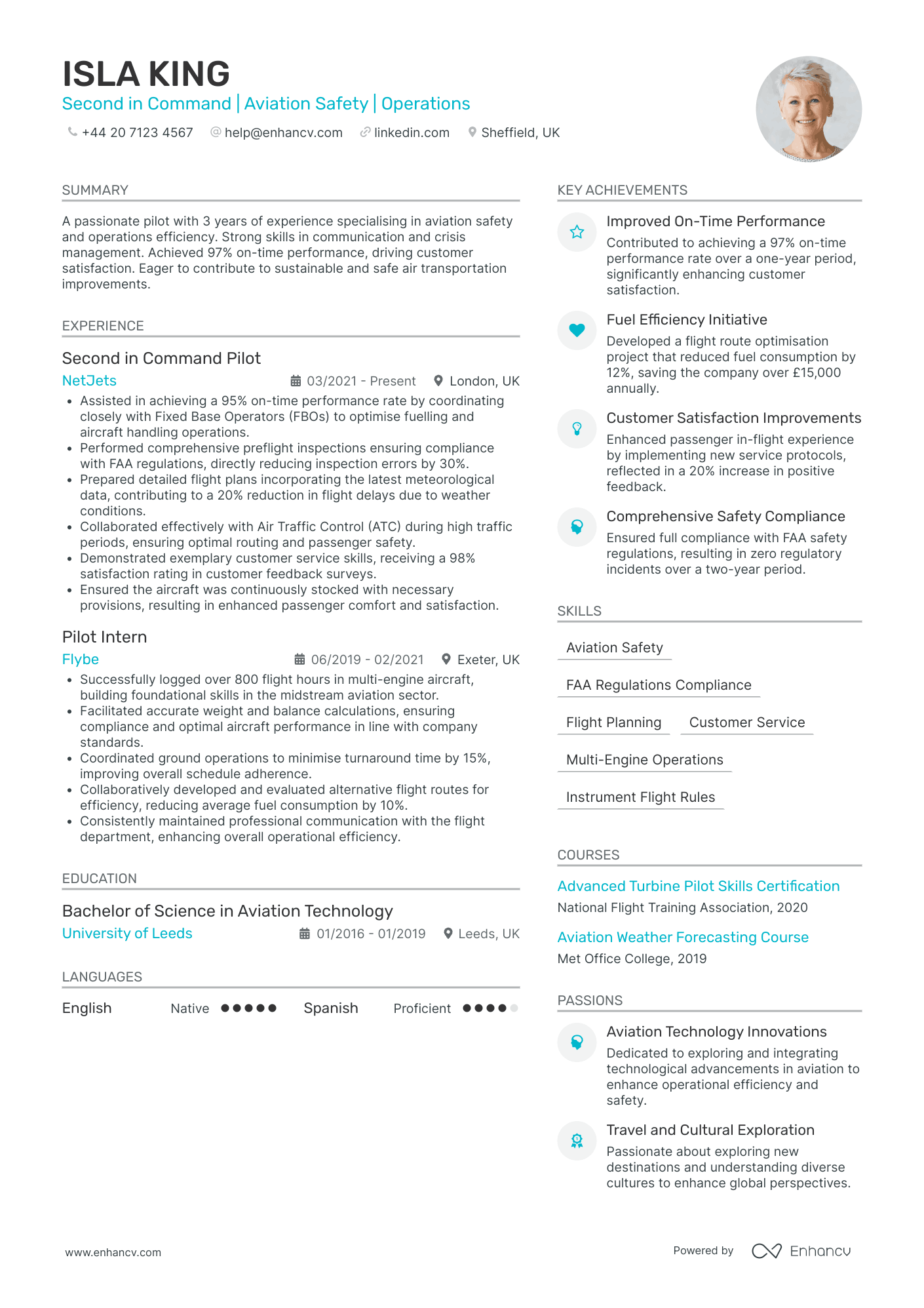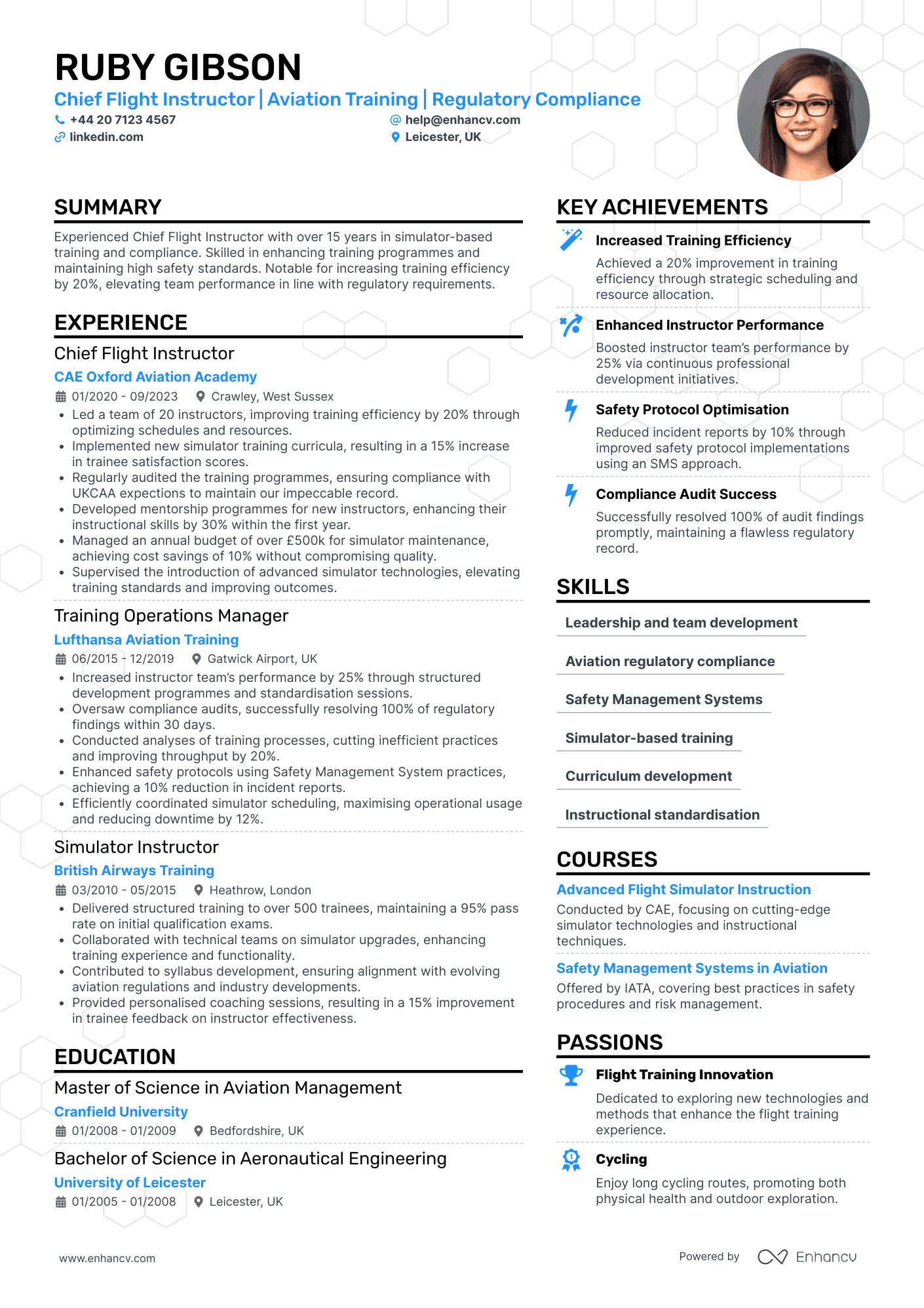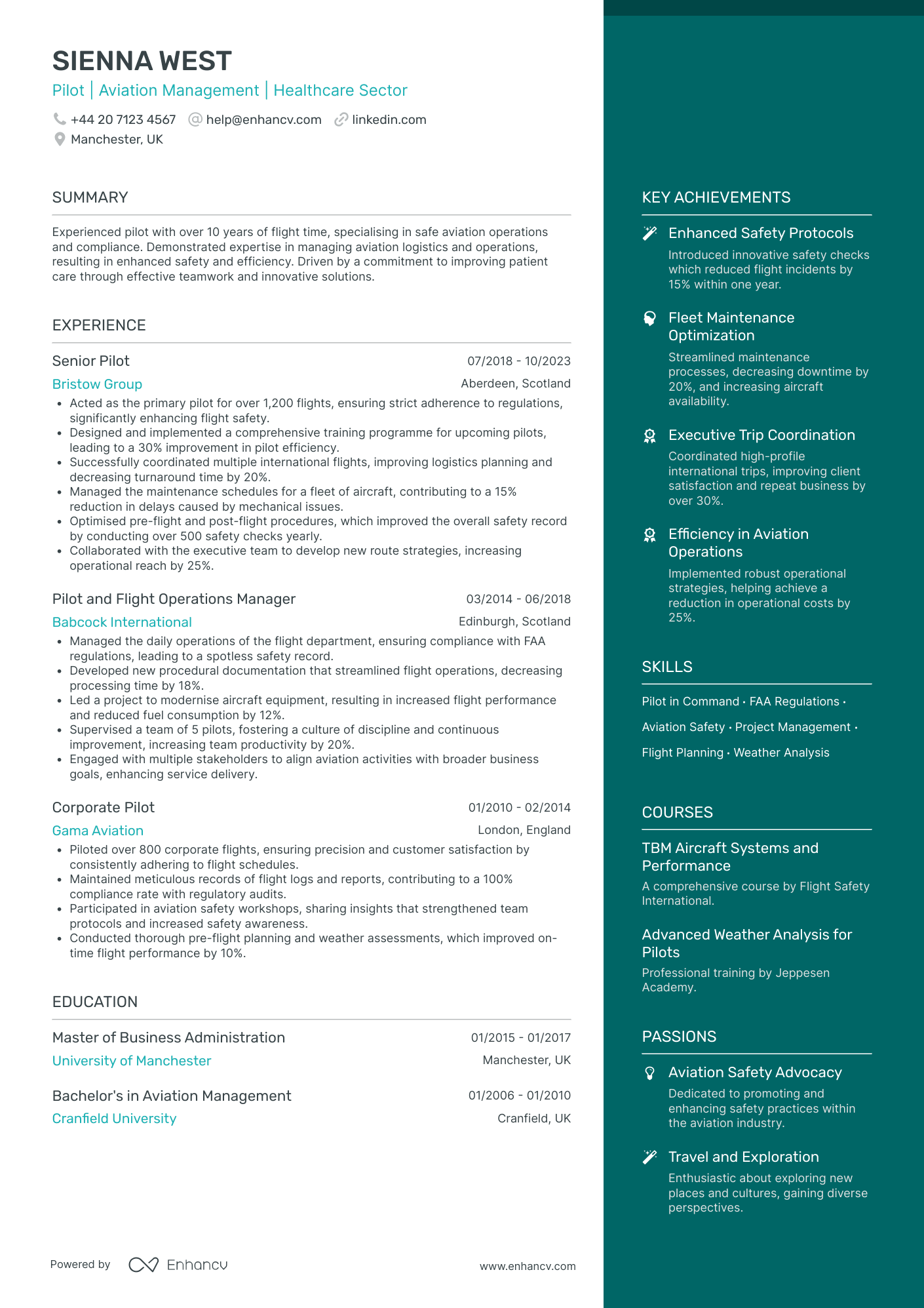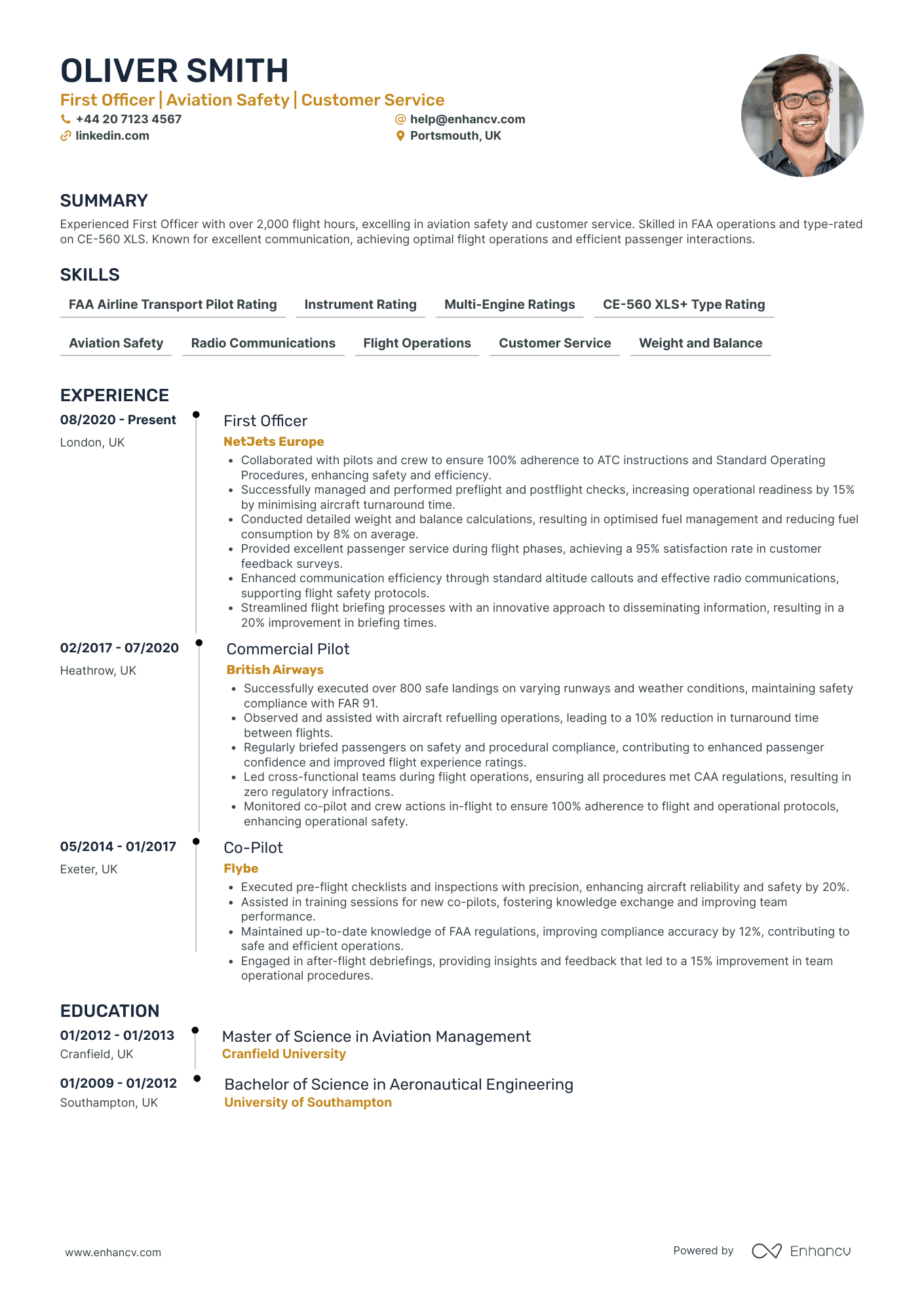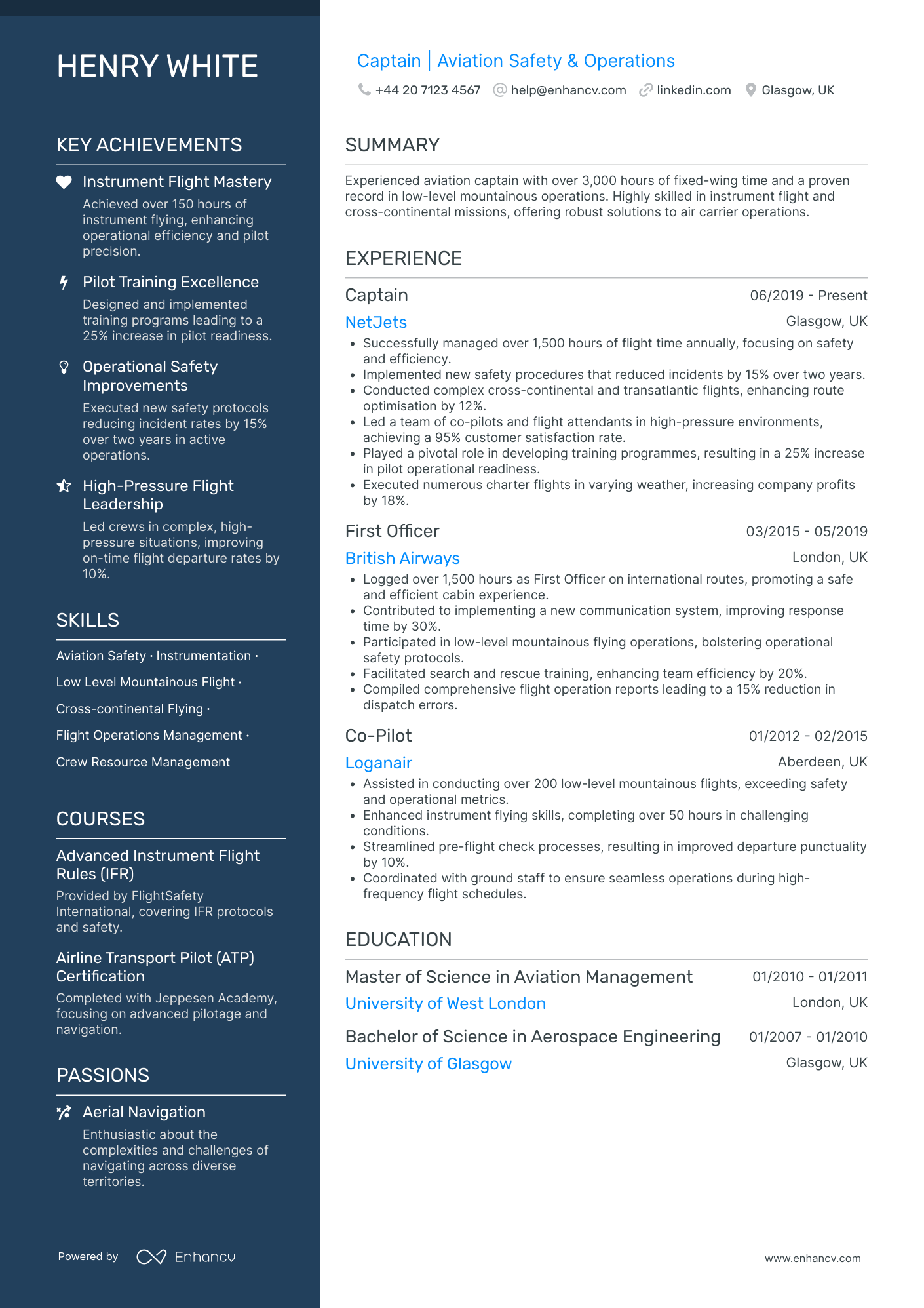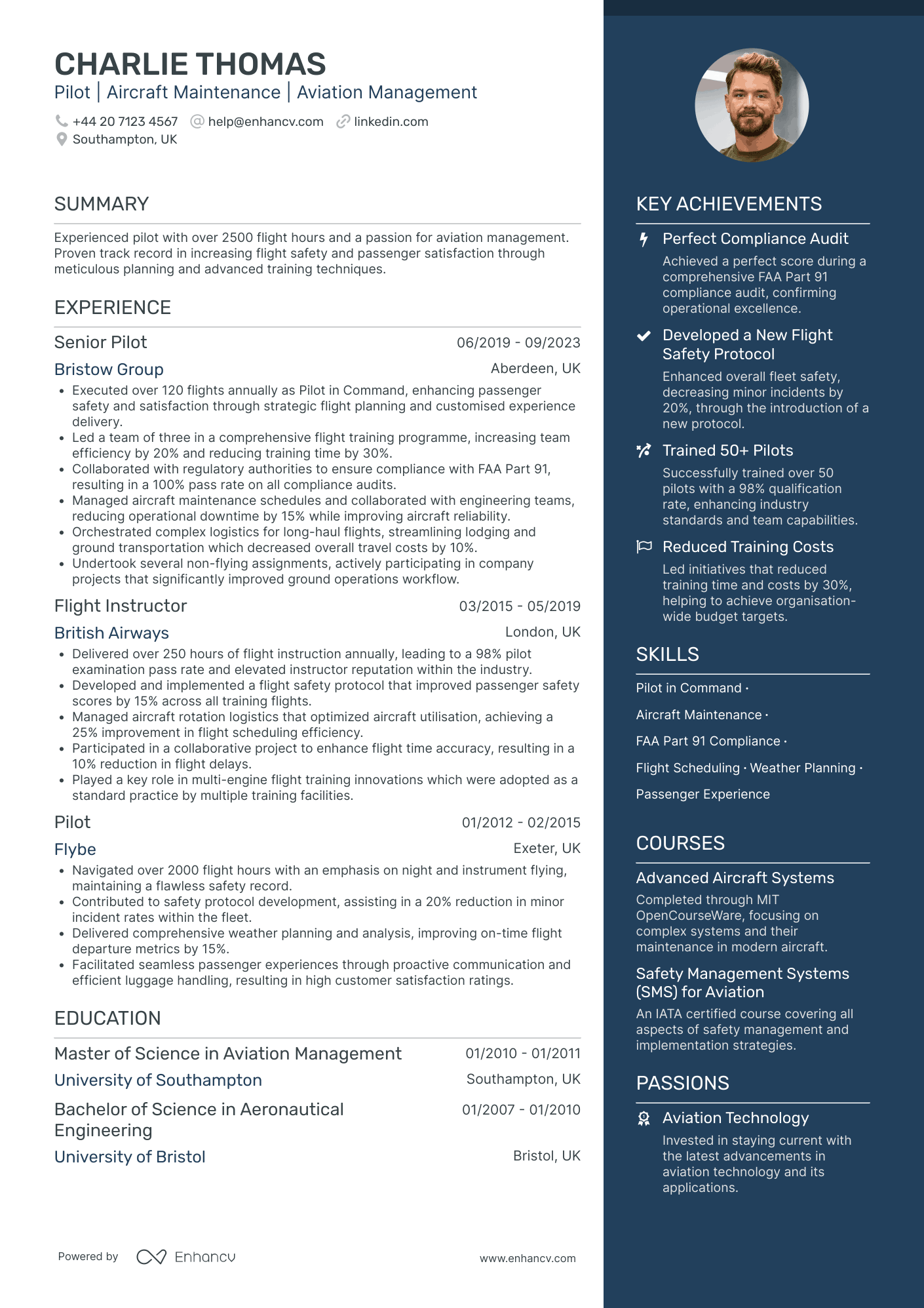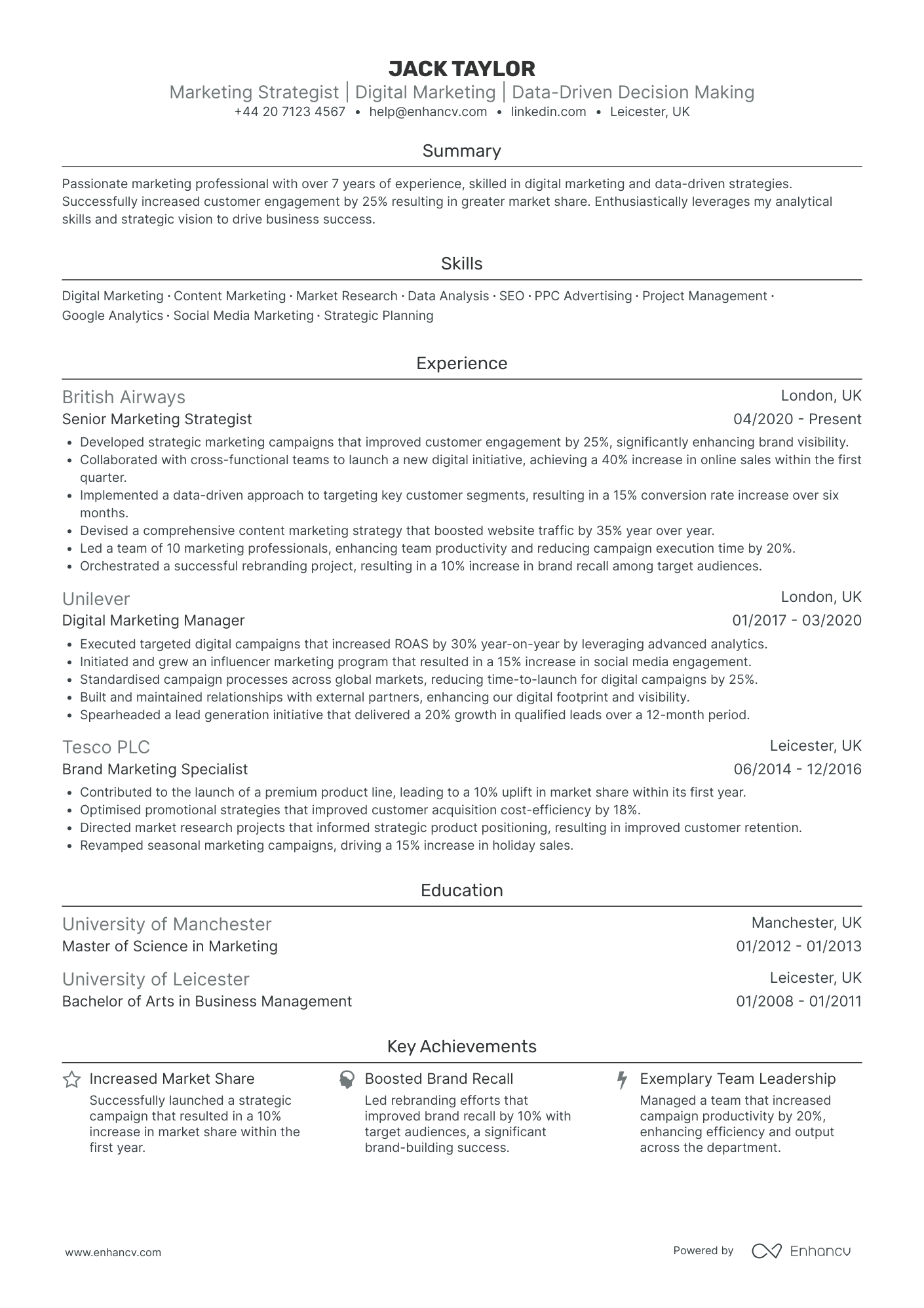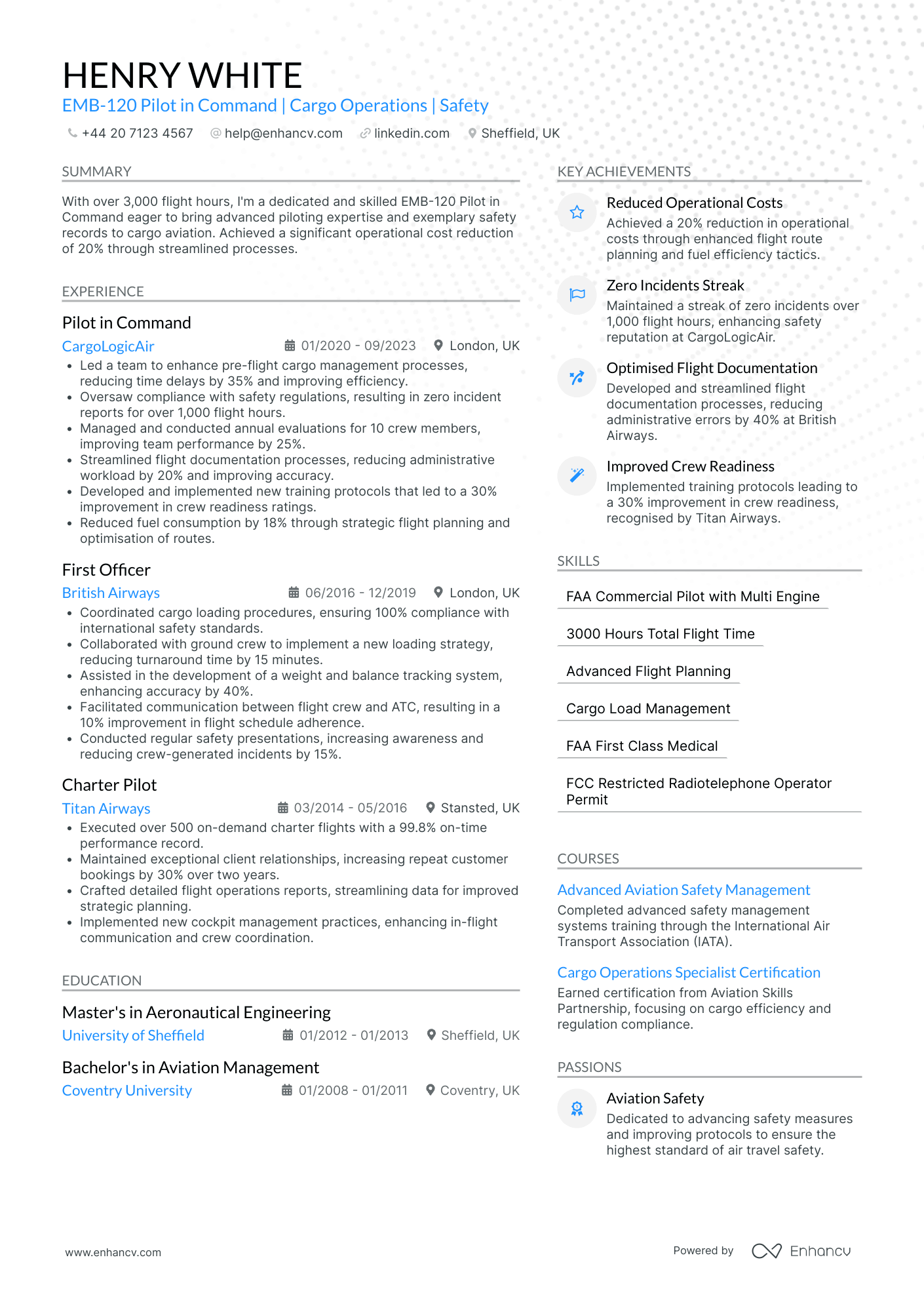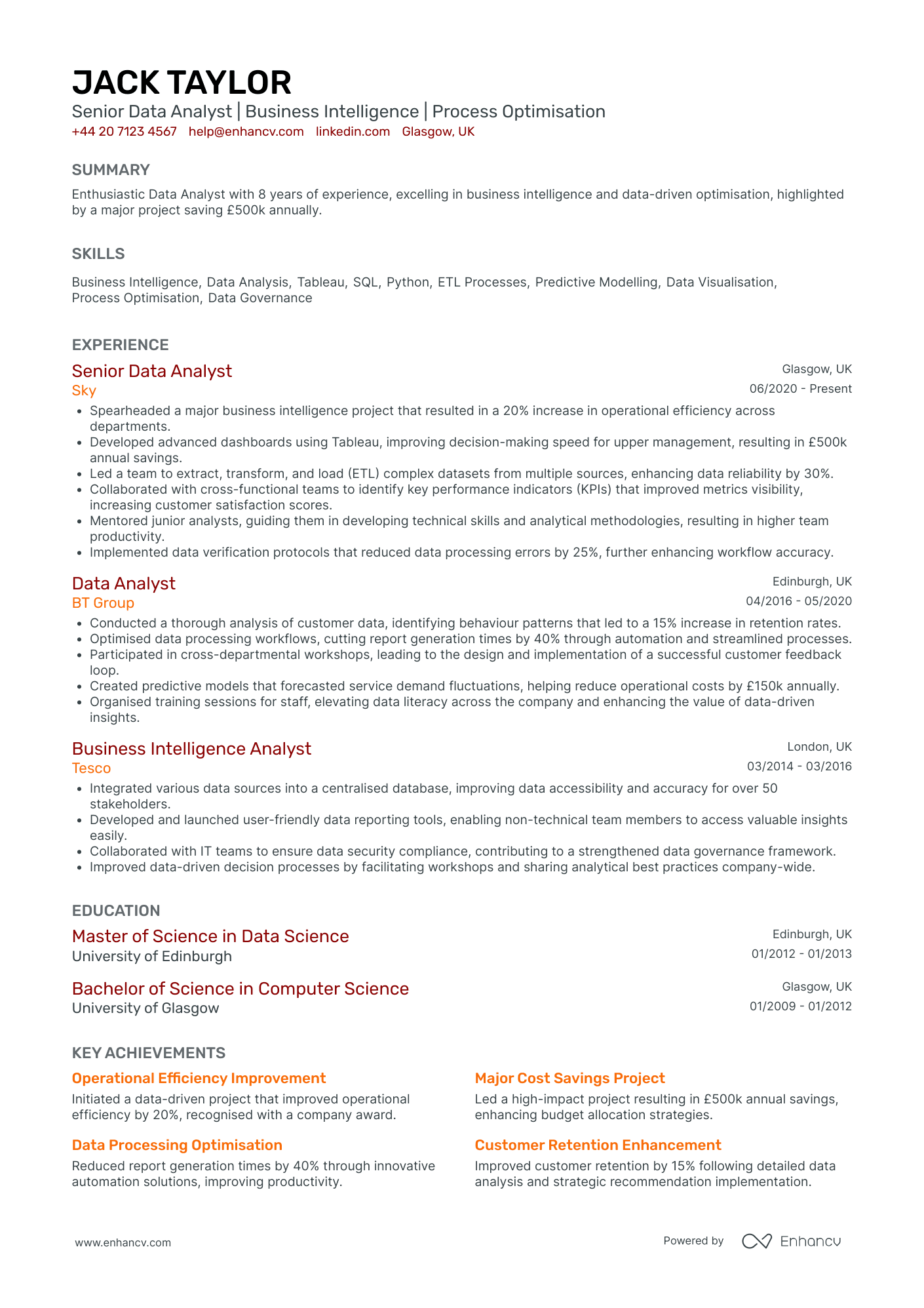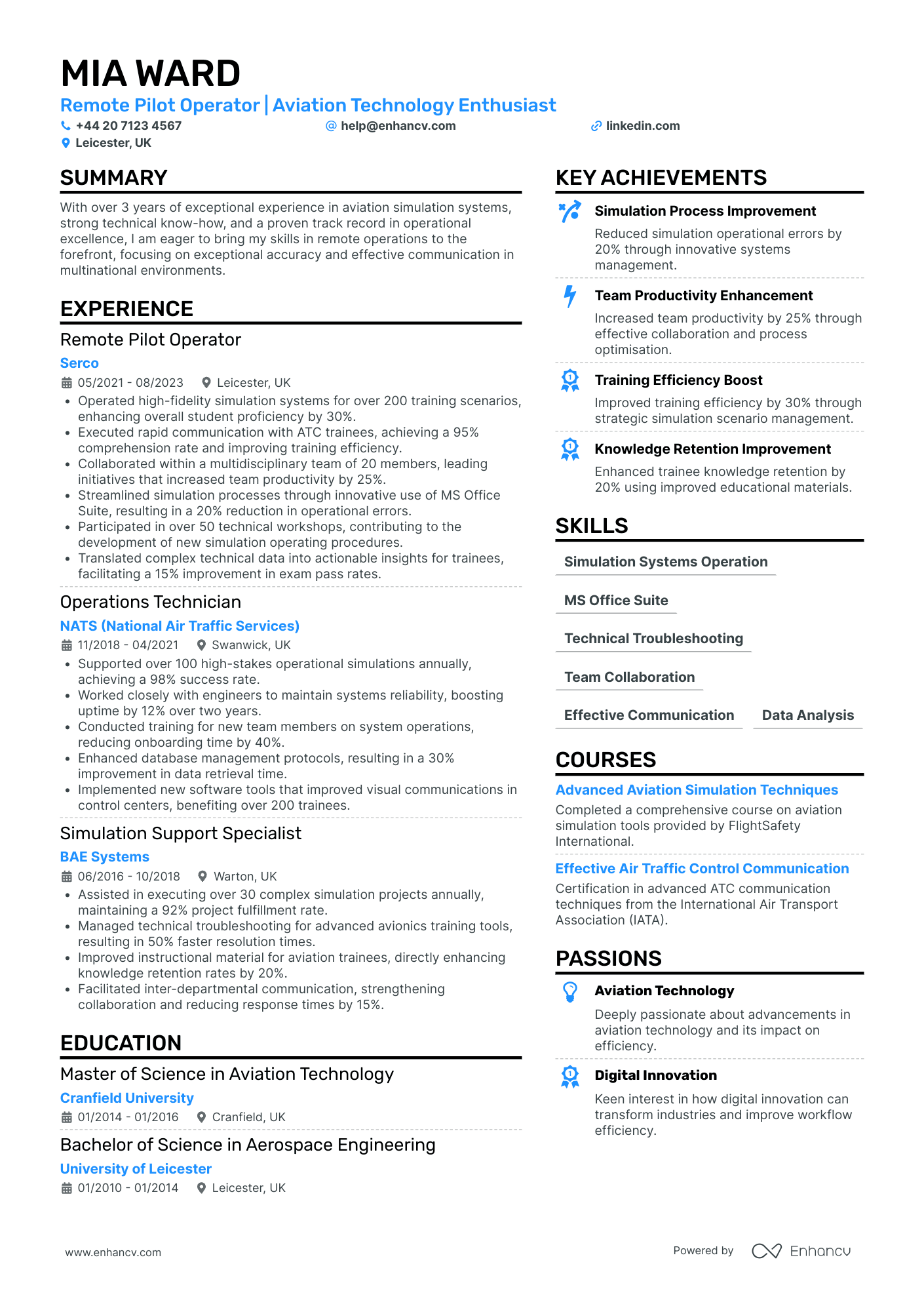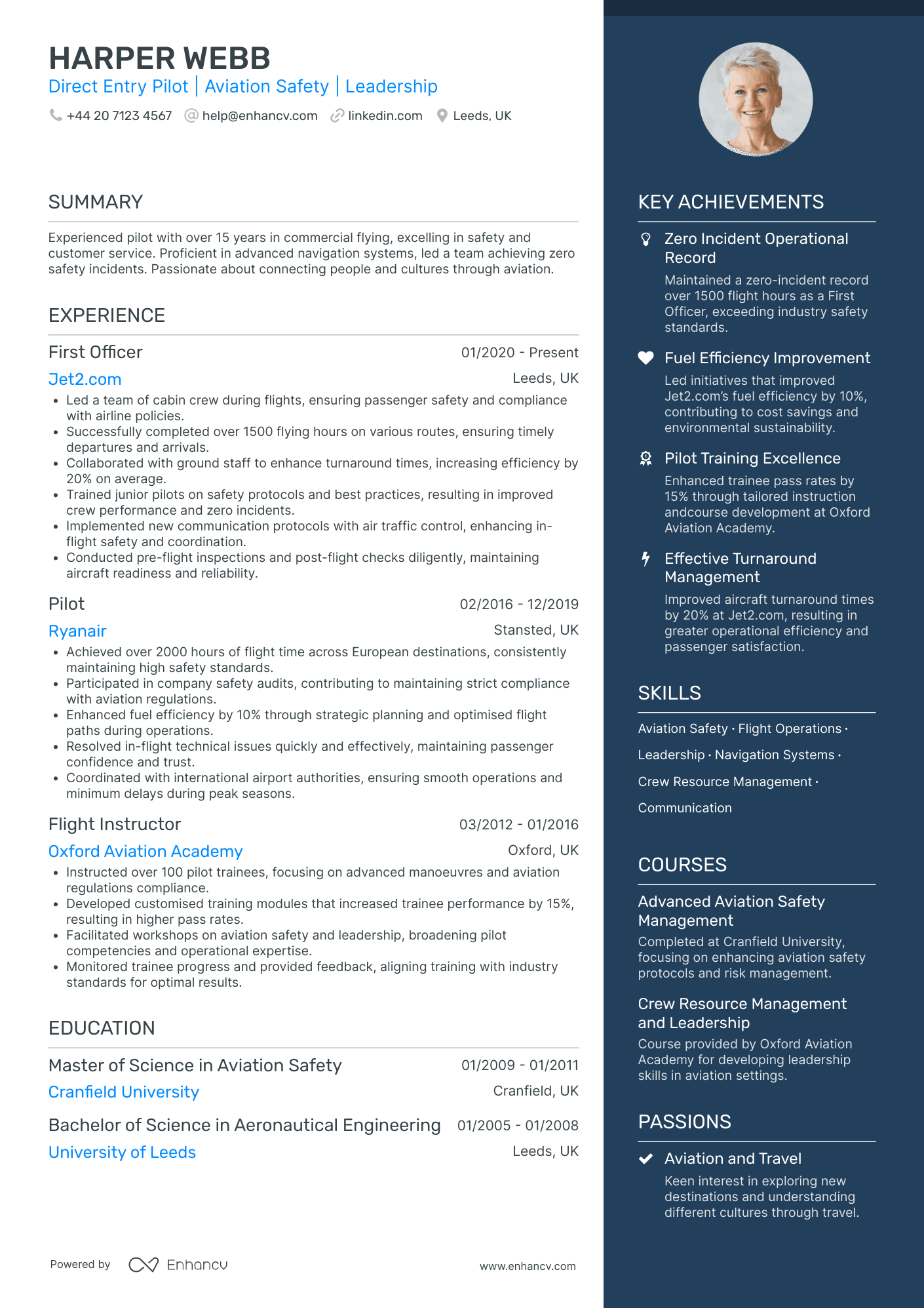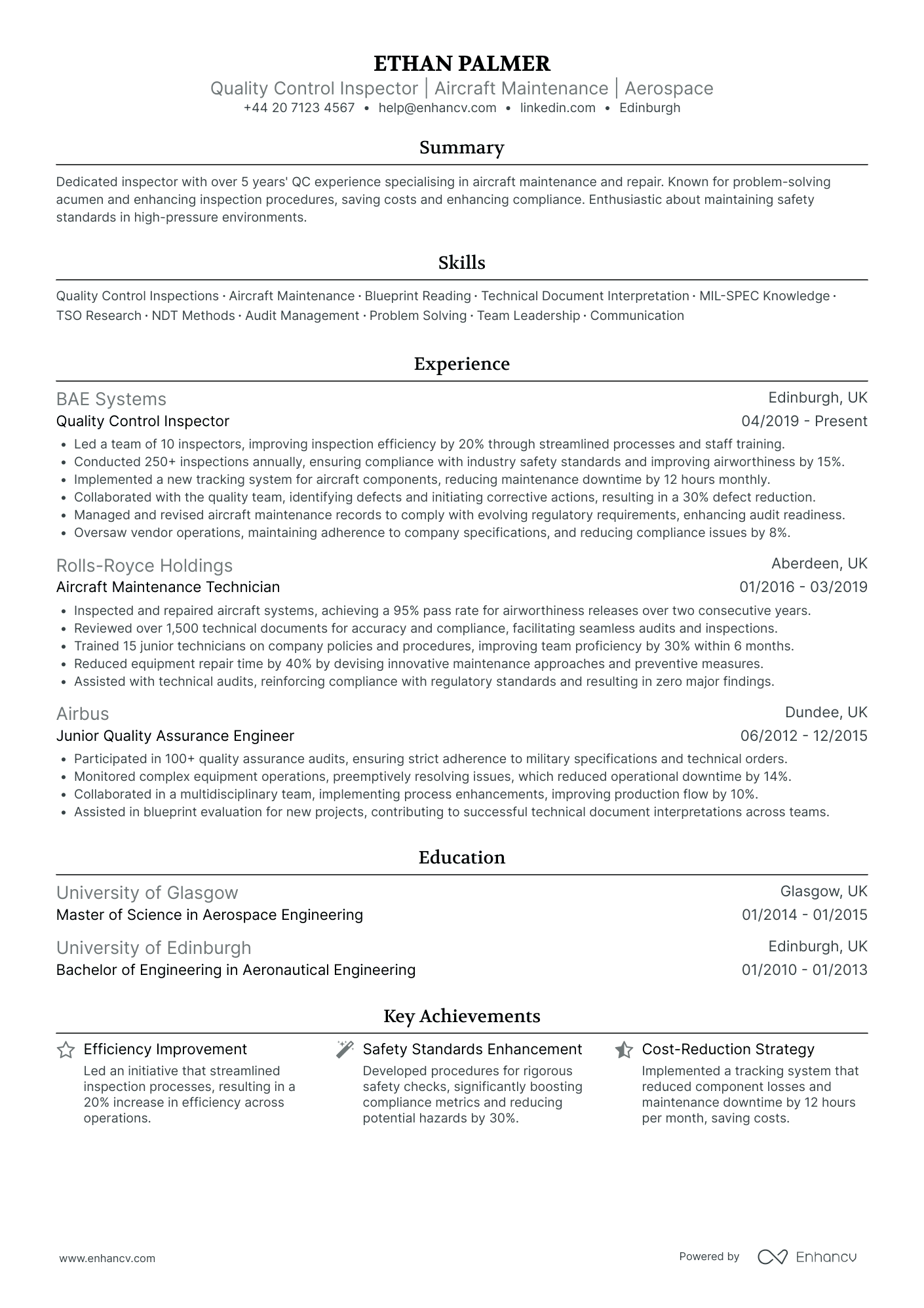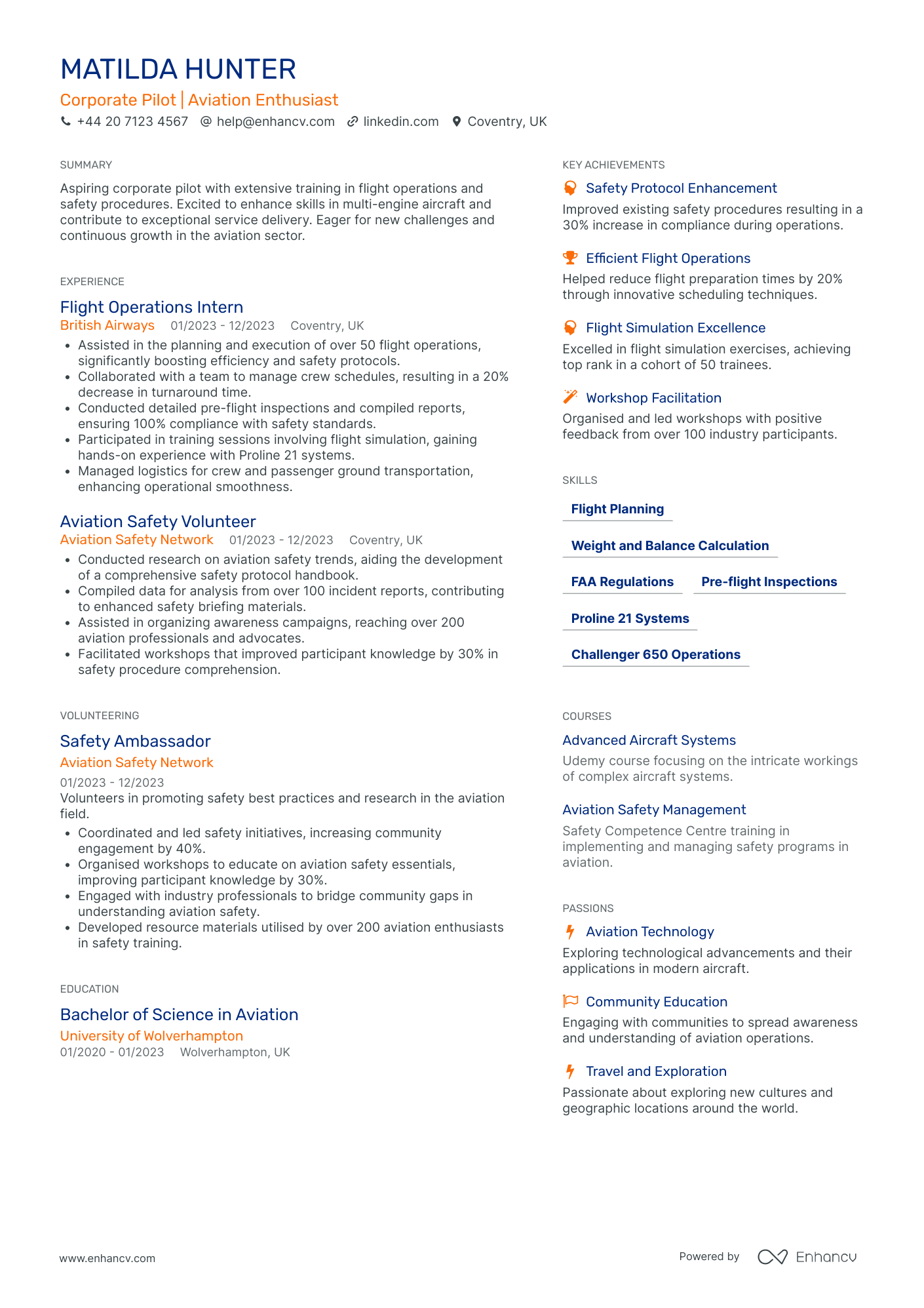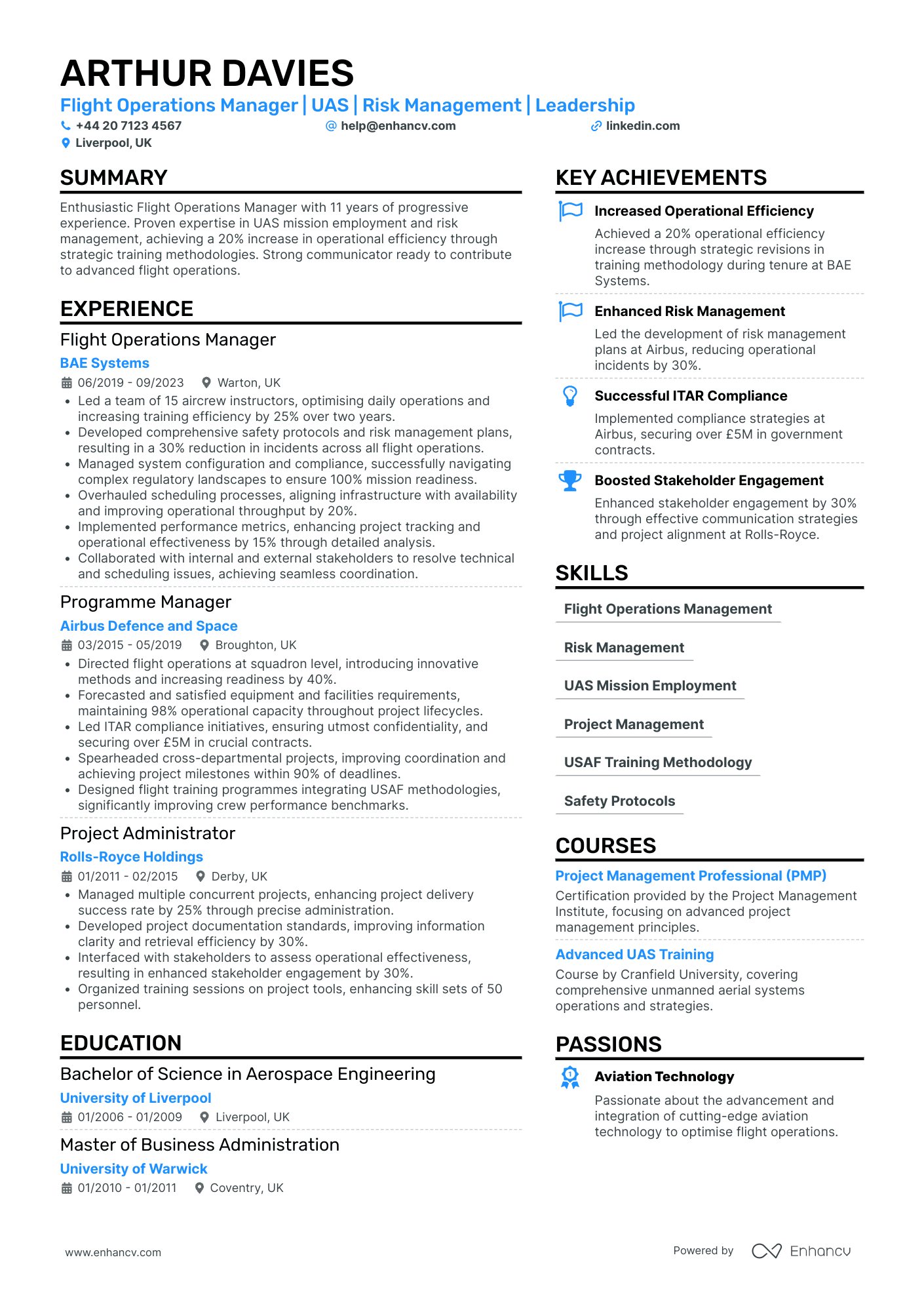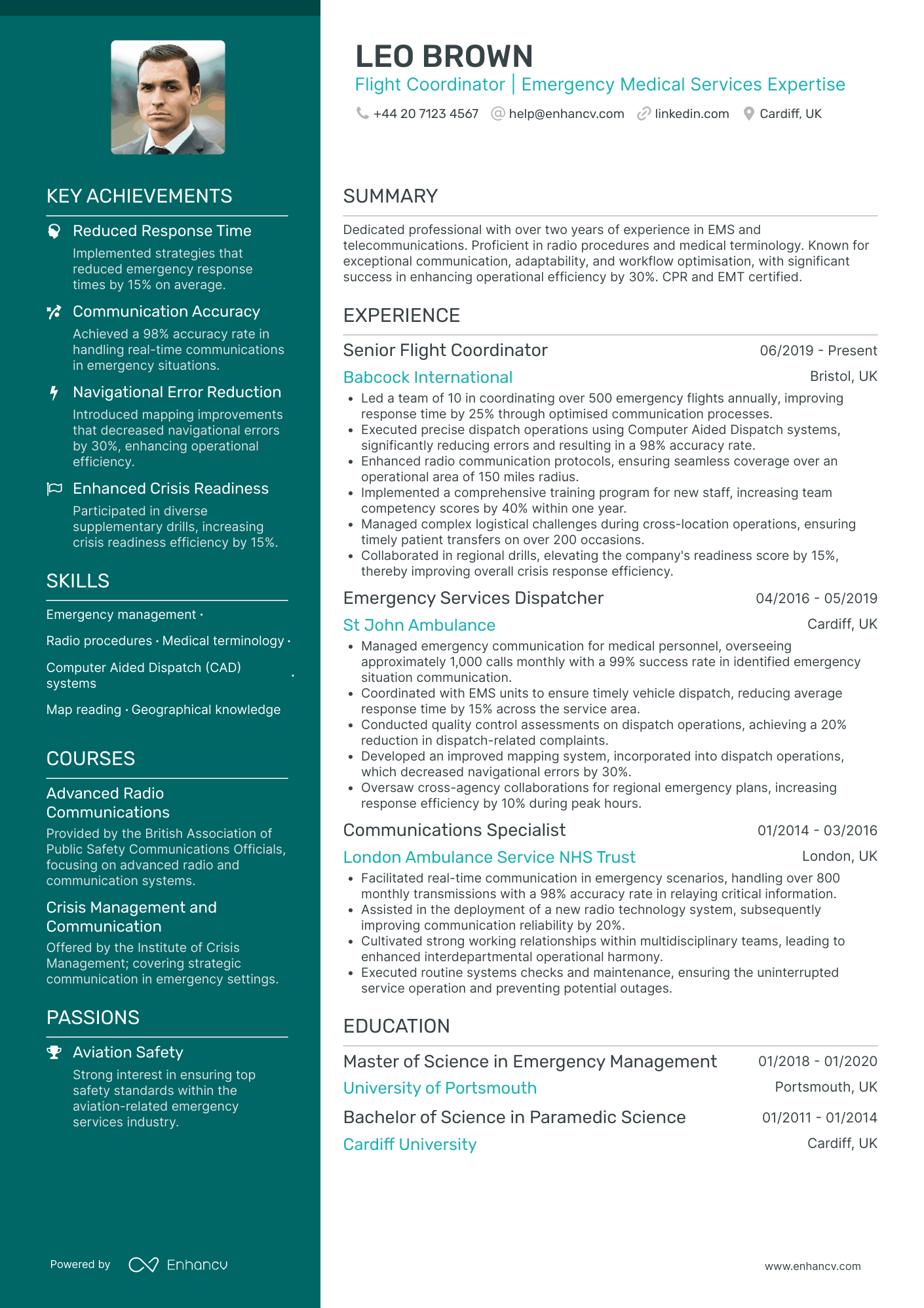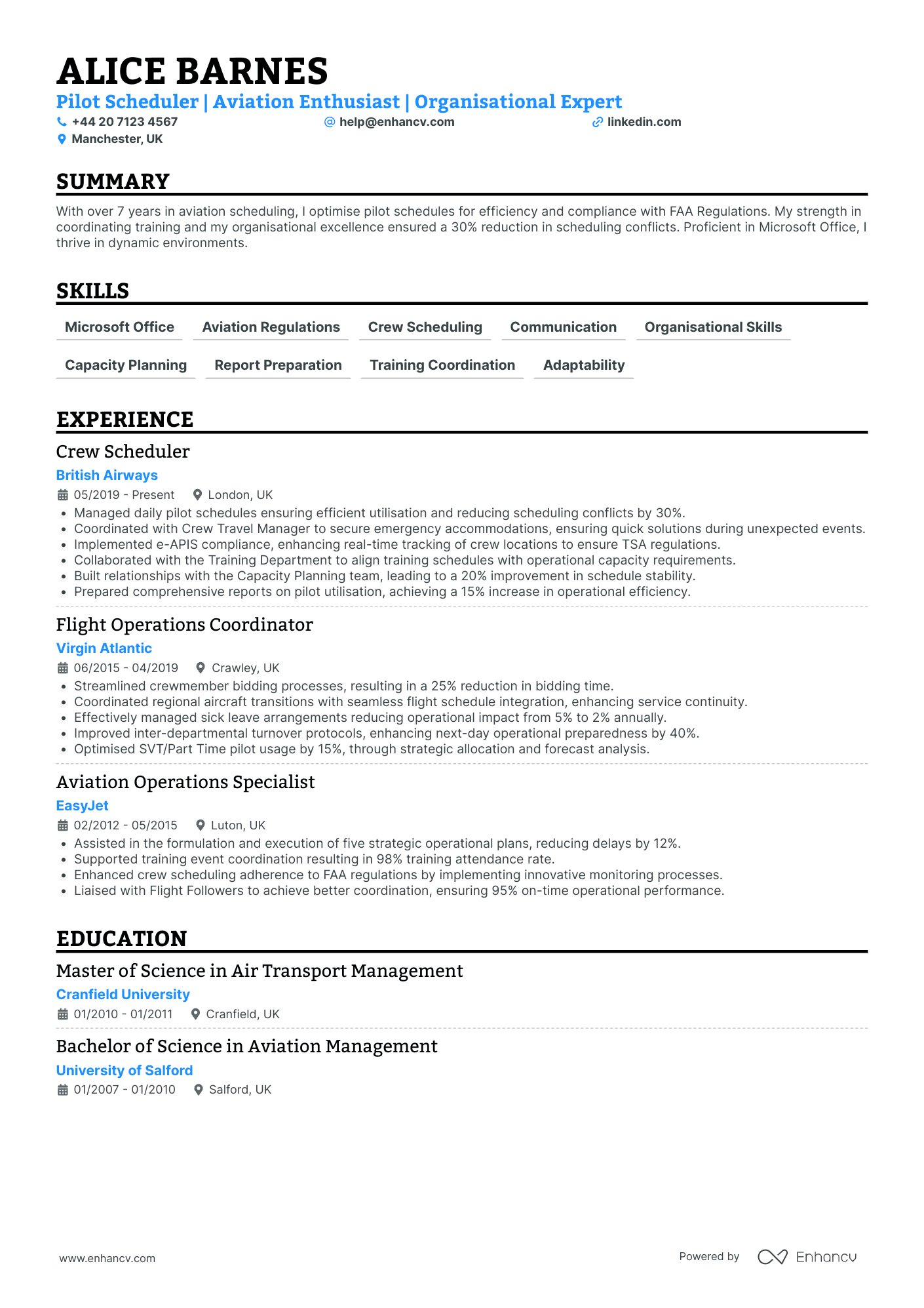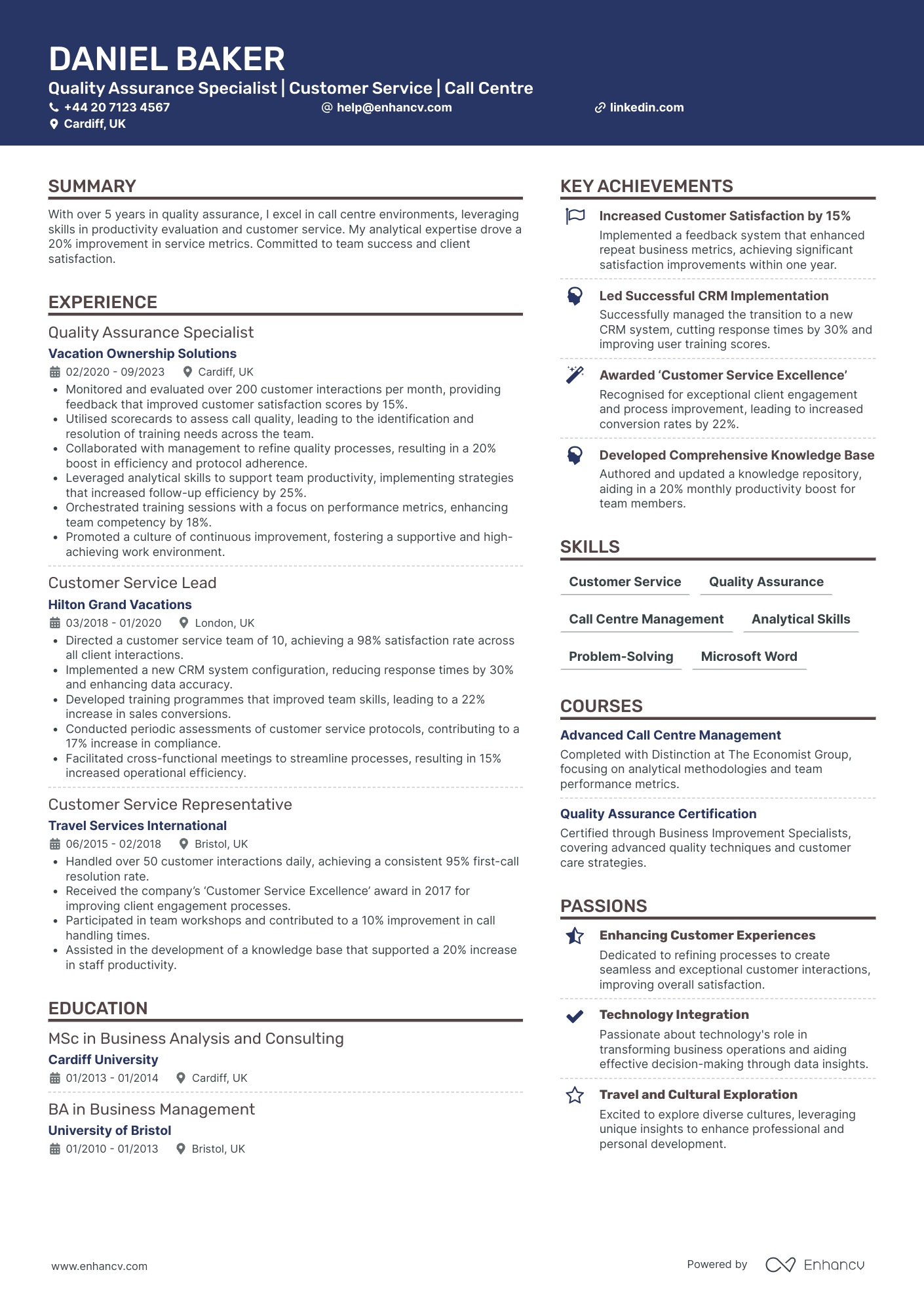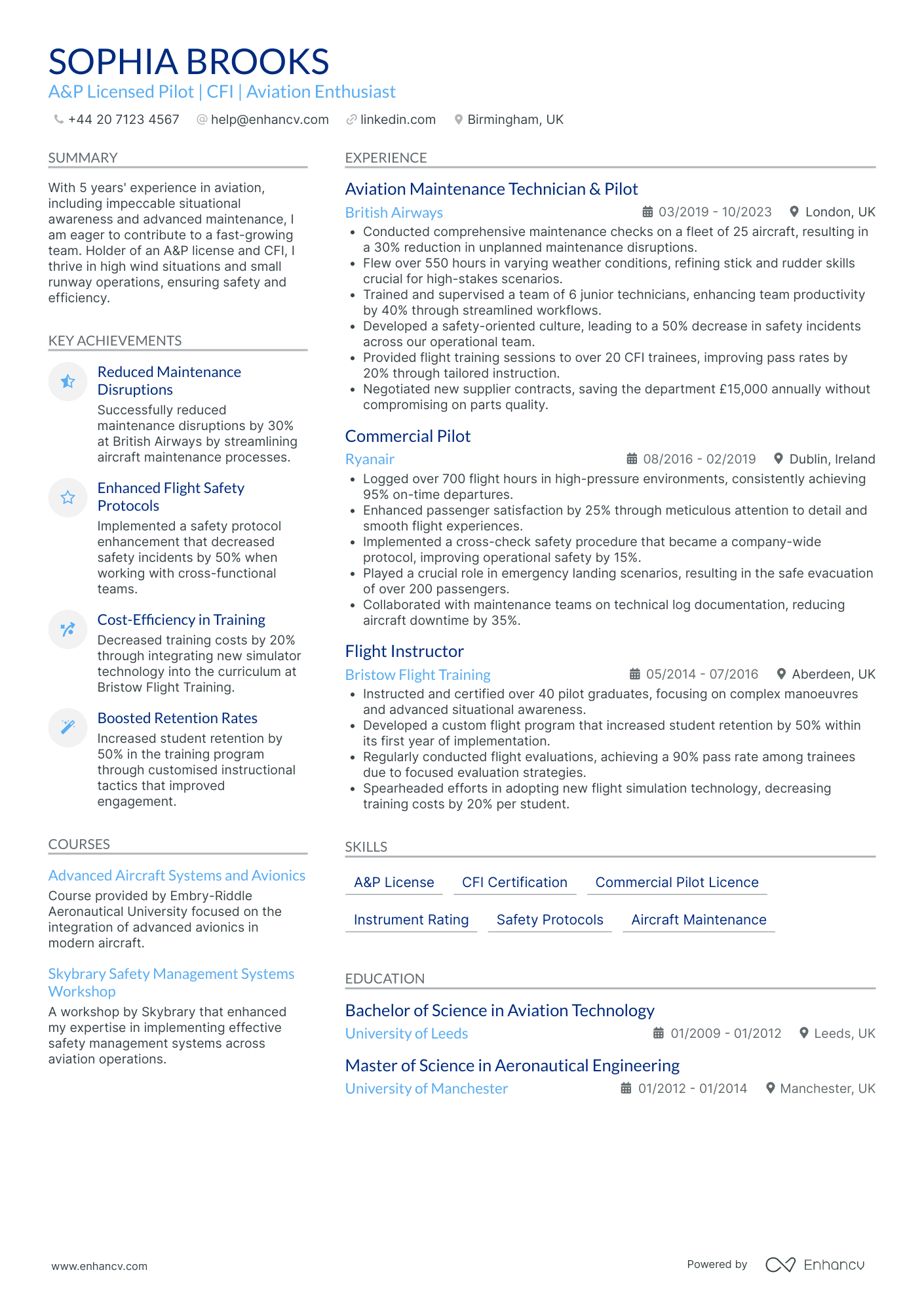One CV challenge you might encounter as an airline pilot is effectively translating your extensive flight hours and technical experience into commercially appealing skills for non-aviation roles. Our guide offers tailored strategies to help you articulate your unique capabilities in a manner that resonates with a broad range of employers, ensuring your CV stands out in a competitive job market.
- Applying best practices from real-world examples to ensure your profile always meets recruiters' expectations;
- What to include in your work experience section, apart from your past roles and responsibilities?
- Why are both hard and soft skills important for your application?
- How do you need to format your CV to pass the Applicant Tracker Software (ATS) assessment?
If you're writing your CV for a niche airline pilot role, make sure to get some inspiration from professionals:
CV examples for airline pilot
By Experience
Senior Airline Pilot
- Clear and Structured Presentation - The CV presents information in a well-organized manner, using clear section headers and bullet points to enhance readability. It efficiently communicates the candidate's qualifications and experience, ensuring that crucial details are easily accessible to potential employers.
- Strategic Career Progression - Jack's career trajectory exhibits a logical progression from Pilot to First Officer, with responsibilities increasing in complexity and scale. This growth within the aviation industry serves as a testament to his commitment and expertise, showcasing a steady advancement into leadership and decision-making roles.
- Emphasis on Soft Skills and Leadership - The CV emphasizes Jack's proficiency in leadership and interpersonal communication, highlighting his ability to lead teams and improve customer satisfaction. These soft skills, coupled with his technical expertise, indicate a well-rounded professional capable of adapting and leading in diverse aviation settings.
Chief Airline Pilot
- Content presentation - Sienna West's CV is exceptionally structured, providing a seamless flow from personal information to specific achievements. Each section is clearly delineated, offering concise yet comprehensive snapshots of her skills and accomplishments.
- Career trajectory - The document outlines a clear progression from Pilot-in-Command to Chief Pilot, demonstrating a trajectory characterized by increasing responsibilities and leadership in aviation management. This ascension highlights her capability to adapt and excel in complex flight operations contexts.
- Unique industry-specific elements - West’s expertise in ISR operations is emphasized throughout, showcasing a niche specialization. Her experience with advanced ISR strategies and systems integration positions her as a thought leader in intelligence surveillance within the aviation sector.
Junior Airline Pilot
- Clear structure and focus on outcomes - The CV is well-organized, presenting each section with clear headings and concise descriptions. It highlights outcomes with specific accomplishments, such as improving on-time performance by collaborating with FBOs, thus demonstrating a direct impact on efficiency and customer satisfaction.
- Progressive career growth in aviation - Isla's career trajectory reflects a path marked by growth and increasing responsibility. Starting as a Pilot Intern and advancing to a Second-in-Command position at a prestigious company like NetJets, this journey showcases her dedication and capability to scale in the aviation industry effectively.
- Emphasis on safety and customer satisfaction - The CV distinguishes Isla in the aviation field with her rigorous focus on safety compliance, shown by reducing regulatory incidents, as well as excelling in customer service, evidenced by high satisfaction ratings and positive feedback increase. These elements underscore her ability to balance operational demands with customer-centric priorities.
By Role
Airline Pilot Instructor
- Clear and Organized Content Presentation - The CV is meticulously structured, providing a clear overview of Ruby Gibson's professional journey by presenting her roles, achievements, and educational background in a coherent and concise manner. Each section is logically organized, allowing for easy navigation through her extensive experience.
- Impressive Career Trajectory - Ruby's career path demonstrates significant growth and leadership progression within the aviation training industry. From her initial role as a Simulator Instructor to her current position as a Chief Flight Instructor, the CV underscores a continuous upward trajectory marked by promotions and expanded responsibilities.
- Specialized Industry Expertise - The CV highlights Ruby's engagement with advanced aviation tools and methodologies such as simulator-based training and Safety Management Systems. Her expertise in implementing regulatory compliance and instructional standardization positions her as a thought leader and innovator in the flight training sector.
Airline Pilot Examiner
- Concise and Structured Presentation - The CV is well-organized with clear headings for each section, facilitating easy navigation. It succinctly outlines the candidate’s career highlights and core competencies in aviation management and healthcare, effectively capturing the attention of potential employers through clarity and precision.
- Robust Career Growth - Sienna West demonstrates a steady career progression from a corporate pilot to roles involving significant leadership responsibilities, such as Senior Pilot and Flight Operations Manager. This trajectory reflects her growing expertise and capacity for handling complex aviation operations and management tasks.
- Emphasis on Safety and Efficiency - The CV showcases Sienna's commitment to enhancing aviation safety through initiatives like innovative safety protocols and maintenance optimization. The mention of reducing flight incidents by 15% and operational costs by 25% underlines her ability to implement effective solutions with tangible business impacts.
Commercial Airline Pilot
- Well-Structured Sections and Flow - The CV utilizes a clean structure, neatly dividing sections like professional summary, career history, skills, and education. This organization enhances readability and allows potential employers to quickly assess the candidate's qualifications and experience, making it easy to pinpoint key information relevant to the job.
- Impressive Career Growth and Industry Experience - The CV details a distinct career trajectory with progressive roles that illustrate the candidate's advancement from an entry-level position to a senior managerial role. Their transition across different sectors such as finance, technology, and healthcare highlights versatility and the ability to adapt skills to various industry-specific demands.
- Unique Skill Set and Technical Aptitudes - Emphasizing technical depth, the CV features industry-specific tools like Salesforce, HubSpot, and Tableau, indicating the candidate's strong analytical ability. Additionally, it details methodologies such as Agile and Lean Six Sigma, underscoring their systematic approach to driving process improvements, which is valuable for strategic planning roles.
Airline Pilot Trainer
- Clear Content Presentation - The CV is structured clearly and concisely, making it easy to navigate through the candidate's career history, education, and achievements. It uses bullet points effectively to summarize responsibilities and outcomes in a manner that is both quick to read and informative, ensuring each key point is delivered with impact.
- Consistent Career Growth - Henry White's career trajectory illustrates consistent growth and advancement within the aviation industry. Starting as a Co-Pilot and progressing through roles of increasing responsibility, culminating in the position of Captain, showcases a steady upward movement, highlighting both experience and leadership development.
- Strong Leadership and Team Management - The CV emphasizes Henry White's leadership skills, particularly in high-pressure situations and team management. By leading teams with a 95% customer satisfaction rate and developing training programs increasing pilot operational readiness by 25%, the CV underscores their ability to drive team performance and improve operational efficiency.
Airline Pilot Recruiter
- Structured and Concise Presentation - The CV is laid out in a logical and easy-to-read manner, with clear headings for each section. Bullet points are used to succinctly present key achievements and responsibilities, making it straightforward for recruiters to identify valuable information quickly. This clarity in presentation ensures that the reader can easily navigate through the candidate’s extensive experience and qualifications without being overwhelmed by unnecessary details.
- Impressive Career Growth and Leadership - The career trajectory outlined in this CV highlights a clear path of progression from a Pilot at Flybe to a Senior Pilot at Bristow Group, indicating strong professional growth. The movement from Flight Instructor to Senior Pilot also underscores leadership capabilities, demonstrating the candidate’s ability to lead teams, mentor new pilots, and take on supervisory roles, underscoring their capacity to enhance team efficiency and compliance within aviation standards.
- Impactful Achievements with Industry-Relevant Outcomes - This CV is particularly effective in demonstrating achievements with real business impacts. For example, reducing operational downtime by 15% and achieving a perfect compliance audit score showcases a direct impact on organizational efficiency and regulatory adherence. These accomplishments are presented in a way that highlights their importance to the aviation industry, underscoring how the candidate’s contributions have enhanced safety, cost-effectiveness, and team capabilities in their previous roles.
Airline Pilot Consultant
- Cohesive career growth - Jack's career progression shows a clear trajectory from a Brand Marketing Specialist to a Senior Marketing Strategist at a major airline. This transition reflects his ability to leverage foundational skills and scale them to meet the demands of higher responsibility roles within diverse industry giants like Tesco, Unilever, and British Airways.
- Emphasis on data-driven methodologies - The CV prominently highlights Jack's use of data analytics to drive marketing strategies. His ability to improve customer engagement and online sales through data-centric campaigns underscores a sophisticated understanding of digital analytics, a crucial component in modern marketing strategy.
- Leadership and teamwork abilities - The CV showcases Jack's leadership strength by detailing his experience leading a team of marketing professionals. Enhancing team productivity and contributing to successful rebranding projects demonstrate his effective management skills and ability to inspire and drive his team toward achieving strategic goals.
Airline Pilot Career Advisor
- Clear and Structured Presentation - The CV is organized in a way that allows easy navigation through different sections, each concisely and systematically presenting the candidate’s qualifications. It starts with a comprehensive header followed by a well-defined summary, which instantly communicates the applicant's credentials and career focus.
- Progressive Career Trajectory - The career path of Henry White demonstrates clear professional growth, progressing from a Charter Pilot to a Pilot in Command. This advancement within major airlines showcases his increasing responsibilities and recognition within the aerospace industry, underpinning his capability to lead in complex cargo operations.
- Strong Leadership and Safety Focus - The CV emphasizes leadership ability and commitment to safety, as seen through his initiatives in safety protocol improvements and crew training. Henry’s direction of compliance and crew management resulted in zero incidents and enhanced team performance, highlighting his influential role in fostering a safety-first corporate culture.
Airline Pilot Union Representative
- Strong Career Progression - Jack Taylor's CV demonstrates a clear upward trajectory, starting as a Business Intelligence Analyst and rising to the position of Senior Data Analyst at a major company. This progression showcases his ability to adapt and grow, highlighting stability and ambition in his chosen field.
- Effective Use of Industry-Specific Tools - The CV highlights proficiency in essential tools like Tableau, SQL, and Python, which are critical for data analysis roles. By emphasizing these, along with ETL processes and predictive modeling, Jack illustrates his technical dexterity and capabilities in handling complex data tasks.
- Impactful Achievements with Quantifiable Results - Jack’s achievements, such as leading a project that saved £500k annually, are not just numbers but convey a significant business impact. This demonstrates his ability to deliver concrete financial benefits through data-driven decision-making, aligning his contributions with the company's strategic goals.
Airline Pilot Simulator Operator
- Structured Presentation with Concise Detail - Mia Ward's CV is well-organized, featuring a clear structure that differentiates between various sections such as experience, education, skills, and achievements. The bullet points describe her responsibilities and accomplishments succinctly, ensuring that each point delivers maximum information without unnecessary verbosity.
- Dynamic Career Growth in Aviation - Mia demonstrates a substantial career progression, transitioning from a Simulation Support Specialist at BAE Systems to a Remote Pilot Operator at Serco. With each position, she has taken on increased responsibility, reflecting her ability to adapt and excel in the dynamic field of aviation technology.
- In-depth Industry Knowledge and Tools - Her expertise with specialized aviation simulation systems and tools such as MS Office Suite and technical troubleshooting reflects a deep technical understanding. Her participation in over 50 technical workshops further emphasizes her commitment to staying updated with the latest developments in aviation technology.
Regional Airline Pilot
- Structured Content Presentation - Harper Webb's CV is crafted for clarity and impact, presenting details in a concise, well-structured format. The use of bullet points for roles and achievements ensures quick readability, while the summary provides a comprehensive overview of their career without overwhelming details.
- Progressive Career Trajectory - Webb demonstrates a strong upward trajectory with roles moving from Flight Instructor to First Officer. This progression illustrates not only career growth but also the ability to adapt to different responsibilities and environments in the aviation industry.
- Industry-Specific Expertise - The CV highlights Webb's deep industry knowledge in aviation safety and navigation systems, evidenced by roles that involve training other pilots and participating in safety audits. This sets them apart as a technically proficient leader within highly regulated aviation settings.
Airline Pilot Safety Inspector
- Content presentation with structured clarity - Ethan Palmer’s CV presents information clearly and concisely, making it easy to follow his career progression. Each section is well-organized, allowing quick identification of key skills and roles, effectively guiding the reader through his professional journey.
- Showcases a solid career trajectory - Ethan’s career path illustrates consistent growth from a Junior Quality Assurance Engineer to a Quality Control Inspector, displaying his capacity for advancement and leadership. His promotions reflect increasing responsibility, suggesting a proactive and ambitious professional dedication within the aerospace sector.
- Industry-specific technical depth and methodologies - The CV highlights Ethan’s use of specific aerospace and maintenance techniques, like Non-Destructive Testing (NDT) and MIL-SPEC compliance. This demonstrates his specialized knowledge, validating his expertise in ensuring safety and operational compliance, crucial for the aerospace industry.
International Airline Pilot
- Content Presentation - The CV is organized logically, allowing for easy navigation and comprehension of key sections such as experience, education, skills, and achievements. Clear headings and bullet points contribute to concise readability and highlight pertinent information efficiently, ensuring that critical details about the candidate’s qualifications and accomplishments are unmissed.
- Career Trajectory - Matilda Hunter showcases a promising career path with steady growth from educational pursuits in aviation to hands-on internships and volunteer roles. Her experience reflects a keen focus on building her expertise in key industry areas like flight operations and safety procedures, underscoring an evident commitment to advancing within the aviation sector.
- Unique Industry-Specific Elements - The CV includes specific technical competencies and systems knowledge such as Proline 21 Systems and Challenger 650 Operations, distinguishing her technical depth and preparedness for corporate pilot roles. This industry-focused skill set directly aligns with the demands of piloting multi-engine aircraft, enhancing her suitability for roles requiring specialized equipment familiarity.
Airline Pilot Flight Operations Manager
- Structured Presentation and Clarity - Arthur Davies’ CV is well-structured, with clear sections that allow readers to quickly grasp key information. The concise summaries of his roles and achievements ensure that his significant contributions in each position are easily understood and noted.
- Impressive Career Trajectory - His career shows an impressive upward trajectory with noticeable advancement from Project Administrator to Flight Operations Manager. This progression illustrates not only his growing responsibilities but also his deepening expertise in the aerospace sector over time.
- Technical Depth in Industry-Specific Elements - Arthur stands out with his deep understanding of UAS mission employment and handling complex regulatory requirements like ITAR compliance. His CV showcases his proficiency with specific tools and methodologies pivotal in aviation, reflecting his specialized knowledge and technical acumen.
Airline Pilot Coordinator
- Clarity and Conciseness in Content Presentation - The CV presents information in a clear and structured manner, with concise bullet points and well-defined sections. This allows the reader to quickly grasp the candidate's qualifications, experience, and achievements. Each section is distinctly labeled, making it easy to navigate through the professional history and skill set of the candidate.
- Impressive Career Trajectory in Emergency Services - Leo Brown showcases a clear growth trajectory within the emergency services industry, moving from a Communications Specialist to a Senior Flight Coordinator. This progression highlights his increased responsibility and expertise in managing high-pressure situations and leading teams, crucial for roles in emergency medical services coordination.
- Unique Industry-Specific Expertise and Tools - The CV highlights deep expertise in emergency medical services, showcasing proficiency in specialized tools like Computer Aided Dispatch (CAD) systems and advanced radio communication protocols. Such technical depth underscores the candidate's ability to manage complex logistical challenges and optimise operational efficiency in emergency settings.
Airline Pilot Crew Scheduler
- Effective Content Presentation and Structure - The CV is well-organized, starting with a concise summary that captures Alice Barnes' strengths and expertise in aviation scheduling. Each section is clearly delineated with bullet points that enhance readability and allow for easy navigation, making it straightforward to grasp her career highlights and skills.
- Progressive Career Trajectory - Alice Barnes' career shows a logical progression within the aviation industry, advancing from an Aviation Operations Specialist at EasyJet to a Crew Scheduler at British Airways. This upward trajectory illustrates her growing expertise and responsibility, highlighting a consistent commitment to her field.
- Specialized Industry Expertise - Her experience showcases in-depth industry knowledge, evidenced by her use of e-APIS compliance for real-time crew tracking and coordination with the Training Department to optimize schedules. These elements reflect her technical proficiency and the application of advanced methodologies central to aviation operations.
Airline Pilot Quality Assurance Auditor
- Clear Structure and Detail Orientation - The CV is structured with well-defined sections that provide a clear narrative of the candidate’s career. Each section is concise yet detailed, spotlighting relevant accomplishments, which make for easy navigation and emphasize key points of interest for a potential employer.
- Progressive Career Development - Daniel Baker has demonstrated a steady career progression, advancing from a Customer Service Representative to a Quality Assurance Specialist. This trajectory reflects not only his increasing responsibilities but also his ability to adapt and excel in varied roles within the customer service and quality assurance sectors.
- Effective Utilization of Analytical Skills - The CV showcases a strong emphasis on analytics, such as scorecard assessments that helped identify training needs, and strategies that boosted team productivity. These elements highlight the candidate's capability to leverage data-driven insights to enhance performance, a critical skill in quality assurance roles.
Airline Pilot Standards Captain
- Impeccable Content Structure and Clarity - The CV stands out for its organized format and clear delineation of sections, which efficiently guides the reader through Sophia’s professional journey. By maintaining a concise format, relevant information is highlighted, allowing quick access to career achievements, technical skills, and educational background.
- Impressive Career Progression and Industry Experience - Sophia's career trajectory showcases a steady progression from a flight instructor to a pilot for major airlines. The role transitions reflect an upward career path marked by increased responsibilities and leadership within respected aviation companies, indicating a strong growth potential.
- High-Level Technical Competence and Aviation-Specific Expertise - The inclusion of specific licenses and certifications like A&P and CFI, alongside courses on advanced aircraft systems, underscores both a broad and in-depth understanding of the aviation industry. This technical depth is complemented by a focus on cutting-edge technologies and methodologies, crucial for a competitive edge in aviation.
How complex should the format of your airline pilot CV be?
Perhaps, you decided to use a fancy font and plenty of colours to ensure your airline pilot CV stands out amongst the pile of other candidate profiles. Alas - this may confuse recruiters. By keeping your format simple and organising your information coherently, you'll ultimately make a better impression. What matters most is your experience, while your CV format should act as complementary thing by:
- Presenting the information in a reverse chronological order with the most recent of your jobs first. This is done so that your career history stays organised and is aligned to the role;
- Making it easy for recruiters to get in touch with you by including your contact details in the CV header. Regarding the design of your CV header, include plenty of white space and icons to draw attention to your information. If you're applying for roles in the UK, don't include a photo, as this is considered a bad practice;
- Organising your most important CV sections with consistent colours, plenty of white space, and appropriate margins (2.54 cm). Remember that your CV design should always aim at legibility and to spotlight your key information;
- Writing no more than two pages of your relevant experience. For candidates who are just starting out in the field, we recommend to have an one-page CV.
One more thing about your CV format - you may be worried if your double column CV is Applicant Tracker System (ATS) complaint. In our recent study, we discovered that both single and double-column CVs are ATS-friendly . Most ATSes out there can also read all serif and sans serif fonts. We suggest you go with modern, yet simple, fonts (e.g. Rubik, Lato, Raleway) instead of the classic Times New Roman. You'll want your application to stand out, and many candidates still go for the classics. Finally, you'll have to export your CV. If you're wondering if you should select Doc or PDF, we always advise going with PDF. Your CV in PDF will stay intact and opens easily on every OS, including Mac OS.

PRO TIP
Use font size and style strategically to create a visual hierarchy, drawing the reader's eye to the most important information first (like your name and most recent job title).

The top sections on a airline pilot CV
- Flight hours detail experience and proficiency.
- Aviation licences and ratings are essential qualifications.
- Relevant education demonstrates foundational knowledge.
- Aviation medical certificate ensures fitness to fly.
- Professional history highlights aviation career progression.

What recruiters value on your CV:
- Include all relevant aviation qualifications, such as your pilot's licence details, ratings, and any type-specific endorsements, as these are critical for airline recruiters who need to ascertain your eligibility to operate their aircraft.
- Detail your flying experience, highlighting total flight hours, multi-engine hours, and any instrument flight rules (IFR) experience, to showcase your capability and readiness for the demands of commercial airline operations.
- Emphasise any leadership roles or responsibilities held during your career, such as training other pilots or acting as a captain, to demonstrate your ability to handle the responsibility and leadership expected of a pilot.
- Outline your educational background, ensuring you include any aviation-related degrees or diplomas, as a solid educational foundation can be advantageous in the highly technical and regulated aviation industry.
- Include any additional skills or certifications such as Crew Resource Management (CRM), safety training, or first aid, that can enhance your profile as a well-rounded candidate prepared for the diverse scenarios encountered by airline pilots.
Recommended reads:
What information should you include in your airline pilot CV header?
The CV header is potentially the section that recruiters would refer to the most, as it should include your:
- Contact details - your professional (non-work) email address and phone number;
- Professional photograph - if you're applying hinting at the value you bring as a professional.
Many professionals often struggle with writing their airline pilot CV headline. That's why in the next section of this guide, we've curated examples of how you can optimise this space to pass any form of assessment.

Examples of good CV headlines for airline pilot:
- Senior First Officer | Wide-Body Aircraft Expert | Crew Leadership | ATPL | 10+ Years Flight Experience
- Airline Captain | Flight Safety Advocate | Type-Rated: A320 Family | CRM Specialist | 15+ Years Airtime
- Chief Pilot | Aviation Operations Management | Recruitment & Training Lead | MPL | 20-Year Flying Tenure
- Commercial Pilot | Jet Turbine Command | Cross-Continental Experience | Frozen ATPL | 5 Years in Aviation
- First Officer | Regional Routes Specialist | Advanced Navigation Techniques | Multi-Engine Rating | 7+ Years Professional Pilot
- Experienced Captain | International Routes | Airline Quality Assurance | TRI | Over 25 Years in Cockpit
Your airline pilot CV introduction: selecting between a summary and an objective
airline pilot candidates often wonder how to start writing their resumes. More specifically, how exactly can they use their opening statements to build a connection with recruiters, showcase their relevant skills, and spotlight job alignment. A tricky situation, we know. When crafting you airline pilot CV select between:
- A summary - to show an overview of your career so far, including your most significant achievements.
- An objective - to show a conscise overview of your career dreams and aspirations.
Find out more examples and ultimately, decide which type of opening statement will fit your profile in the next section of our guide:

CV summaries for a airline pilot job:
- Seasoned airline pilot with over 15 years of experience commanding 747 and 787 airliners, skilled in advanced navigation systems and adept at executing high-pressure emergency procedures. Boasts a commendable track record of zero safety incidents and recipient of the 'Pilot of the Year' award twice.
- Decorated former naval aviator with 20 years of flying experience transitioning to commercial aviation with expertise in multi-engine aircraft and a solid foundation in international flight operations. Known for exceptional leadership skills and a strong ability to make critical decisions under stress.
- Former healthcare manager with an unwavering passion for aviation seeking to leverage a decade of strategic operational experience into a new career path as a commercial pilot. Completed rigorous flight training programme with top grades and praised for quick adaptability and analytical skills in flight simulations.
- Dynamic professional with a rich background in engineering and physics seeking to leverage 7 years of technical project management into a rewarding career in aviation. Recently completed a comprehensive flight certification course with flying colours and demonstrates acute attention to detail and rigorous adherence to safety protocols.
- Eager to embark on an aviation career as a commercial pilot, offering a fresh perspective and relentless dedication to mastering aircraft systems and flight operations. Eager to learn from seasoned professionals and contribute to a culture of safety and precision. Committed to continuous personal and professional development.
- Highly motivated individual with a strong interest in aviation and customer service, aiming to begin a career as a pilot with a reputable airline. Ready to undergo rigorous training and embrace challenges, aiming to ensure passenger comfort and safety as ultimate objectives.
More detailed look into your work history: best advice on writing your airline pilot CV experience section
The CV experience is a space not just to merely list your past roles and responsibilities. It is the CV real estate within which you could detail your greatest accomplishments and skills, while matching the job requirements. Here's what to have in your experience section:
- Prove you have what the job wants with your unique skill set and past successes;
- Start each bullet with a strong, action verb, and continue with the outcome of your responsibility;
- Use any awards, nominations, and recognitions you've received as solid proof of your skill set and expertise;
- align your experience with the role responsibilities and duties.
For more help on how to write your CV experience section, check out the next section of our guide:

Best practices for your CV's work experience section
- List specific types of aircraft you have experience with, including the total number of hours flown for each type. Mention any advanced systems you are certified to operate within those aircraft.
- Detail your flight experience by dividing it between PIC (Pilot in Command), SIC (Second in Command), day, night, cross-country, international, and instrument flight hours, as applicable. Highlight any unique aviation environments or weather conditions you've successfully navigated.
- Include any experience with safety protocol development, safety audits, or incident reporting as airlines highly value safety expertise. Describe any contributions you've made towards improving safety standards.
- If you've had the opportunity to train or instruct other pilots, mention your role as a mentor or instructor, including the type of instruction (simulator, in-flight, etc.) and the clientele (new hires, upgrading captains, etc.). Training roles show leadership and a solid grasp of aviation knowledge.
- For those with military experience, mention the type of military missions flown and any leadership roles undertaken. This could range from transport to reconnaissance or combat missions and shows a level of versatility and discipline.
- Include the management of any emergency situations, such as technical failures, medical emergencies on board, or severe weather evasions. How you dealt with these emergencies reflects your capability to stay calm and make critical decisions under pressure.
- Reference your understanding and compliance with international aviation regulations, as well as your experience in flight planning and execution according to global airspace rules. Global experience is particularly valuable for international carriers.
- Outline your experience in pre-flight briefing and de-briefing processes, showcasing your communication skills and comprehensive approach to flight operations. Effective communication highlights your ability to work as part of a cohesive team.
- Detail any involvement in fuel planning and management, showcasing your awareness of cost-efficiency and environmental considerations. Efficient fuel management is an important aspect of airline operations.
- Captain on Boeing 787 Dreamliner, handling over 200 transatlantic flights with a focus on maintaining a perfect safety record and passenger satisfaction.
- Implemented new crosswind landing techniques which increased landing safety margins by 15% during adverse weather conditions.
- Mentored and coached over 30 first officers, ensuring compliance with all aviation regulations, which led to enhanced crew preparedness and a reduction in training time by 20%.
- Operated Airbus A320 for various domestic and international routes, accumulating 3,000+ flight hours and maintaining a punctuality record of 95%.
- Actively participated in Fleet Transition Program, aiding in the seamless integration of A321 aircraft into existing fleet operations.
- Led a safety initiative that revamped the pre-flight checklist procedure, minimizing potential oversights and increasing the overall safety score of the airline by 10%.
- Served as a first officer on Boeing 737s, assisting in the execution of flights to high-density airports, thus refining traffic negotiation strategies and reducing flight delays.
- Played a pivotal role in a fuel-saving project that cut fuel consumption by 5%, leading to significant cost savings for the airline.
- Assisted in revamping emergency procedures, leading to a 20% faster emergency passenger evacuation time during drills.
- Commanded regional flights on CRJ-700 aircraft, consistently achieving a 98% on-time performance rate while ensuring a safe and comfortable experience for passengers.
- Contributed to the development of a regional pilot training program, which boosted the graduation rate of new pilots by 25%.
- Collaborated with maintenance teams to identify and reduce recurrent technical issues, leading to a 30% decrease in delays due to mechanical faults.
- Operated long-haul international flights on Airbus A380, resulting in above industry average customer satisfaction scores due to exceptional service and flight management.
- Spearheaded in-flight entertainment upgrade project, increasing passenger engagement by 40% and generating additional revenue streams.
- Conducted comprehensive de-icing procedure reviews, which decreased winter ground delays by an average of 12 minutes per affected flight.
- Held the role of first officer on Boeing 777, facilitating over 150 safe long-haul flights annually and receiving commendations for excellent teamwork and communication.
- Engaged in advanced weather radar training, significantly improving the ability to anticipate and navigate meteorological challenges.
- Contributed to a task force aimed at reducing carbon emissions, achieving a 7% reduction in emissions through optimized flight paths and aircraft performance monitoring.
- Managed a fleet of Embraer E-175 aircraft as a captain, adeptly coordinating with air traffic control and successfully reducing average flight times by optimizing routes.
- Piloted over 250+ domestic flights per year, with a focus on adhering to strict operational and safety standards, which bolstered the airline's industry reputation.
- Led the co-development of a new CRM protocol to enhance communication between cockpit and cabin crew, improving operational efficiency and in-flight service quality.
- Performed as a co-pilot on various short-haul routes, playing a key role in maintaining a 99.7% accuracy for takeoffs and landings within allotted time slots.
- Initiated a peer-review process for flight operations, contributing to a culture of continuous improvement and knowledge sharing among the flight deck team.
- Assisted in evaluating new electronic flight bag (EFB) solutions, leading to a 20% reduction in paper usage and streamlined flight operations.
- Served as a line pilot for regional routes, excelling in precise navigation and fuel management that surpassed company benchmarks for efficiency and cost-savings.
- Instrumental in the implementation of real-time weather tracking systems onboard, significantly improving flight safety and passenger comfort during turbulent conditions.
- Facilitated critical in-flight decisions, leading to zero safety incidents and upholding the airline's impeccable safety record during tenure.
- Operated flights as a captain on Bombardier Q400 aircraft, enhancing reliability and punctuality across the northeastern United States corridor.
- Played an instrumental role in the crew mentorship program, accelerating the transition of junior pilots to line-ready status by 3 months.
- Advocated for and helped implement an automated flight information system, reducing pilot workload and contributing to a more seamless operation.
Writing your CV without professional experience for your first job or when switching industries
There comes a day, when applying for a job, you happen to have no relevant experience, whatsoever. Yet, you're keen on putting your name in the hat. What should you do? Candidates who part-time experience , internships, and volunteer work.
Recommended reads:

PRO TIP
Talk about any positive changes you helped bring about in your previous jobs, like improving a process or helping increase efficiency.
Describing your unique skill set using both hard skills and soft skills
Your airline pilot CV provides you with the perfect opportunity to spotlight your talents, and at the same time - to pass any form of assessment. Focusing on your skill set across different CV sections is the way to go, as this would provide you with an opportunity to quantify your achievements and successes. There's one common, very simple mistake, which candidates tend to make at this stage. Short on time, they tend to hurry and mess up the spelling of some of the key technologies, skills, and keywords. Copy and paste the particular skill directly from the job requirement to your CV to pass the Applicant Tracker System (ATS) assessment. Now, your CV skills are divided into:
- Technical or hard skills, describing your comfort level with technologies (software and hardware). List your aptitude by curating your certifications, on the work success in the experience section, and technical projects. Use the dedicated skills section to provide recruiters with up to twelve technologies, that match the job requirements, and you're capable of using.
- People or soft skills provide you with an excellent background to communicate, work within a team, solve problems. Don't just copy-paste that you're a "leader" or excel at "analysis". Instead, provide tangible metrics that define your success inusing the particular skill within the strengths, achievements, summary/ objective sections.
Top skills for your airline pilot CV:
ATPL (Airline Transport Pilot Licence)
Multi-engine experience
Instrument rating
Flight planning and navigation
Aircraft systems knowledge
Complex aircraft operation
Advanced meteorology
Safety and emergency procedures
Radio operation and communication
Air traffic control compliance
Situational awareness
Decision-making
Leadership
Communication
Problem-solving
Teamwork
Attention to detail
Stress management
Adaptability
Time management

PRO TIP
Use mini case studies or success stories in your CV to demonstrate how your skills have positively impacted previous roles or projects.
Education and more professional qualifications to include in your airline pilot CV
If you want to showcase to recruiters that you're further qualified for the role, ensure you've included your relevant university diplomas. Within your education section:
- Describe your degree with your university name(-s) and start-graduation dates;
- List any awards you've received, if you deem they would be impressive or are relevant to the industry;
- Include your projects and publications, if you need to further showcase how you've used your technical know-how;
- Avoid listing your A-level marks, as your potential employers care to learn more about your university background.
Apart from your higher education, ensure that you've curated your relevant certificates or courses by listing the:
- name of the certificate or course;
- name of the institution within which you received your training;
- the date(-s) when you obtained your accreditation.
In the next section, discover some of the most relevant certificates for your airline pilot CV:

PRO TIP
If you have received professional endorsements or recommendations for certain skills, especially on platforms like LinkedIn, mention these to add credibility.
Recommended reads:
Key takeaways
Your successful job application depends on how you well you have aligned your airline pilot CV to the job description and portrayed your best skills and traits. Make sure to:
- Select your CV format, so that it ensures your experience is easy to read and understand;
- Include your professional contact details and a link to your portfolio, so that recruiters can easily get in touch with you and preview your work;
- Write a CV summary if you happen to have more relevant professional experience. Meanwhile, use the objective to showcase your career dreams and ambitions;
- In your CV experience section bullets, back up your individual skills and responsibilities with tangible achievements;
- Have a healthy balance between hard and soft skills to answer the job requirements and hint at your unique professional value.
